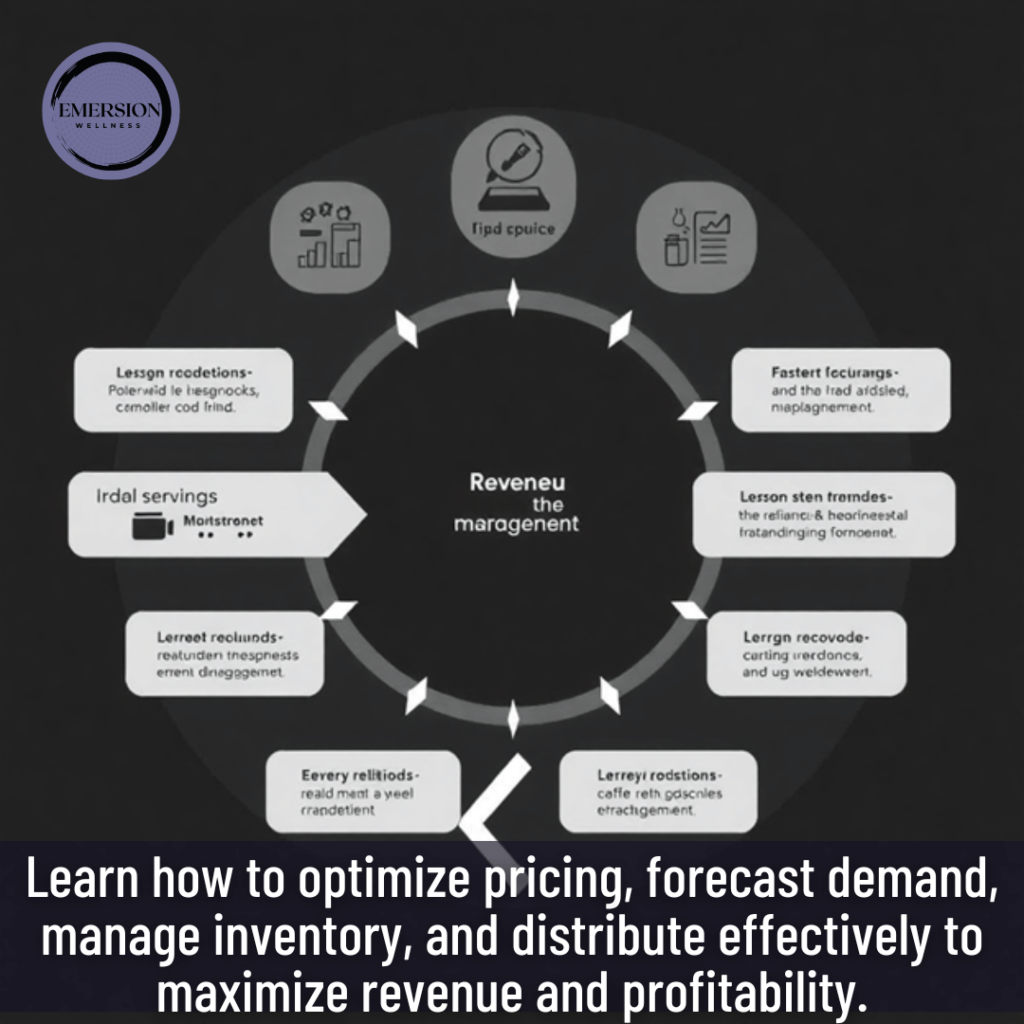Introduction
I’ve been in the hotel business for over fifteen years, and if there’s one thing I’ve learned, it’s this: the revenue management cycle in hotels isn’t just a process—it’s a lifeline. I’ve watched the industry twist and turn, with online booking sites taking over, economies shifting like sand, and guests expecting more every day. In this chaos, knowing how to manage revenue isn’t optional—it’s what keeps your hotel alive and growing.
This guide is straight from my playbook. It’s everything I’ve picked up about the revenue management cycle in hotels, broken down into four stages I’ve wrestled with and mastered: forecasting demand, pricing rooms, controlling inventory, and handling distribution. I’ll share stories from my career—some wins, some hard lessons—and give you practical steps to try yourself. My aim is to hand you the tools to lift your hotel’s revenue and set it up for the long haul. Let’s get into it.
What You’ll Take Away:
- The revenue management cycle in hotels is a nonstop effort to get rates, room availability, and bookings working together for profit.
- Nailing your demand forecast means smarter pricing and fewer headaches.
- Flexible pricing keeps you cashing in when demand spikes and filling rooms when it dips.
- Inventory control stops you from overbooking or missing out on sales.
- Distribution gets your hotel seen by the right people at the right time.
What Makes the Revenue Management Cycle Tick
The revenue management cycle in hotels is like keeping a garden growing—you’re always tending it, watching for changes, and adjusting to get the best yield. It’s about using what you know to set rates, manage rooms, and reach guests, all to bring in the most money possible. I’ve spent late nights hunched over spreadsheets, tweaking plans, and cheering when the numbers line up. It’s a loop of planning, doing, and checking that keeps your hotel on track.
Let’s dig into the four parts of the revenue management cycle in hotels and see how they’ve shaped my work.
Forecasting: Guessing the Future, but Smartly
Forecasting kicks off the revenue management cycle in hotels, and it’s where I feel like a fortune-teller with a calculator. You’re trying to figure out how many guests will show up weeks or months down the road. I’ve always found it thrilling—piecing together bits of info to predict what’s coming. Get it right, and you’re golden; miss it, and you’re scrambling.
Here’s what I look at:
- What’s Happened Before: I pull up old booking records to see when we’ve been packed or empty—like clockwork every July or dead in February.
- The Local Buzz: I check what’s going on nearby—think art fairs, sports events, or a factory opening—that might draw a crowd or clear them out.
- What Others Are Charging: I peek at rates from hotels down the street to gauge where mine should sit.
- The Wild Cards: Weather, holidays, even road construction—I weigh anything that could nudge bookings up or down.
One summer, I was at a lakeside hotel where families flocked every June. I went through years of data, noted when schools closed, and watched the weather reports. We saw a big wave coming, bumped rates a touch, and filled every room at a higher price than the year before. That’s the power of forecasting in the revenue management cycle in hotels.
Why It’s a Big Deal: It’s your crystal ball. Without it, you’re guessing on rates and risking empty rooms or angry guests.
Keeping It Fresh: I don’t just make one forecast and call it a day. I check it every week, sometimes every morning, tweaking as bookings shift or news breaks.
A Lesson Learned: Once, I ignored a last-minute convention announcement, thinking it wouldn’t hit us. Demand spiked, we weren’t ready, and we missed out on higher rates. Now, I stay glued to what’s happening.

Pricing: Finding the Sweet Spot
With a forecast in hand, the next stop in the revenue management cycle in hotels is pricing. This is where I get to play strategist—setting rates that match what’s coming. I use what I call flexible pricing, adjusting based on the moment. It’s not about squeezing every penny out of guests; it’s about keeping rooms full and money rolling in.
Here’s how I do it:
- Following the Flow: I raise rates when things heat up—like a holiday rush—and ease them down when it’s quiet to lure more folks in.
- Eyeing the Neighbors: I watch what other hotels charge to keep my rates in line without selling myself short.
- Longer Stays, Better Deals: I cut a little off for guests who stay a few nights—it’s good for them and keeps my numbers solid.
- Who’s Booking: I tweak prices for different people—business travelers pay more Tuesday, families get a break on Saturdays.
I managed a little mountain lodge once that went dead in the fall. We lowered rates just enough, threw in a free hike guide, and pitched it to weekend adventurers. Suddenly, we had cars in the lot and cash in the bank when we’d usually be twiddling our thumbs.
Gut Meets Data: Numbers tell me a lot, but I lean on my instincts too. After years of this, I can feel when a rate’s off, and I fix it fast. That’s what drives the revenue management cycle in hotels.
Staying Quick: Things change—a competitor drops prices, a storm’s brewing—and I’m ready to shift gears.
Trying Stuff Out: I’ll test a small discount or a premium rate for a weekend, see how it lands, and build on what works.
Dodging Traps: I’ve learned not to jack rates up too high too quick—it sends guests running—or drop them so low we look cheap. It’s a dance I’ve gotten better at.
Inventory: Every Room’s a Puzzle Piece
Inventory control is a huge chunk of the revenue management cycle in hotels, and it’s where I’ve had to roll up my sleeves the most. It’s about deciding how many rooms to sell, who gets them, and where they book from. Mess it up, and you’re either turning folks away or staring at empty beds.
Here’s my game plan:
- No Over or Under: Overbooking means upset guests and extra costs; underbooking means lost cash. I use my forecasts to hit the mark.
- Big Groups, Big Plans: Weddings or company retreats can take over fast. I set rules, haggle rates based on how many and how long, and keep tabs on every spot.
- Upgrades That Pay: I offer a nicer room for a small upcharge—like a balcony view—making guests happy and padding the bottom line.
I was at a downtown hotel once where we kept overbooking by accident. Guests were mad, and we were paying for rooms elsewhere. I tightened our tracking, watched every channel like a hawk, and started pushing upgrades instead of saying no. It flipped the script—fewer headaches, more revenue.
Daily Check-Ins: I look at inventory every day, shuffling rooms if one channel’s hot and another’s not.
Guest-First Thinking: I keep the people in mind—a smooth stay or a surprise upgrade can turn a one-timer into a regular.
Why It Counts: Inventory control in the revenue management cycle in hotels is how you make every night a winner.
A Close Call: I once held too many rooms for a group that canceled late. Now, I’m careful not to overcommit until it’s locked in.
Distribution: Spreading the Word
The last leg of the revenue management cycle in hotels is distribution—how you get your rooms out there for booking. It’s about reaching far and wide while keeping profits close, and I’ve learned it’s a balancing act worth perfecting.
The OTA Game: Sites like Expedia and Booking.com are giants—they show your hotel to the world. I work with them but push for fair cuts and track how many bookings they bring.
Direct Is King: Nothing beats a guest booking on our site—no fees, just us and them. I’ve juiced these up with extras—like a free coffee at check-in—and a booking page that’s dead simple.
Getting Loud: I send emails to past guests with deals, run ads where travelers hang out online, and give loyalty folks a reason to stick with us. One hotel I ran sent a “miss you” email with a discount, and direct bookings shot up overnight.
Turning the Tide: I helped a small inn cut its OTA habit. We spruced up the website, added a free parking perk for direct books, and watched the savings stack up as guests skipped the middleman.
Price Parity: I make sure rates match everywhere—our site, OTAs, agents—so guests trust us.
Why It’s Key: Distribution in the revenue management cycle in hotels is your megaphone—it gets you heard and booked.
New Frontiers: I’m always sniffing out fresh ways to sell—like local travel blogs or Instagram ads—to keep the pipeline full.
Guests: The Real Revenue Drivers
Here’s a truth I’ve come to live by: the revenue management cycle in hotels isn’t just about rates—it’s about the people sleeping in those rooms. When guests leave smiling, they come back, write rave reviews, and bring friends. That’s pure gold.
Here’s how I make it happen:
- Service With Soul: I teach my crew to care—remembering a guest’s name or fixing a glitch fast wins hearts.
- Hearing Them Out: I jump on every comment, good or bad, to show we’re listening.
- Little Extras: A quick note in their room or a tip about a local spot makes them feel at home.
I tried a wellness idea once, sparked by Emersion Wellness. We offered a healthy living package—workouts, good food—and guests ate it up, booking spa time and meals to go with it. Revenue climbed, and folks kept returning.
The Payoff: Happy guests fuel the revenue management cycle in hotels with repeat visits and word-of-mouth buzz.
Fixing What’s Broken: I take every complaint as a chance to get better, tweaking what we do to keep them coming back.
A Brand That Sticks
A solid brand is a secret weapon in the revenue management cycle in hotels—it’s what makes you stand out and keeps guests loyal. I’ve seen it turn a hotel into a destination.
Who We Are: I figure out what sets us apart—luxury, value, quirkiness—and run with it.
Stories That Hook: I tell tales about our roots or the town to pull guests in.
Online Everywhere: A clean website, chatty social media, and fast review replies keep us visible.
The Ritz-Carlton’s service obsession shows how a brand lifts the revenue management cycle in hotels—they charge more because they deliver more. I aim for that vibe.
Keeping It Real: I make sure our style—colors, words, vibes—stays the same everywhere.
Loyalty Loop: A great brand builds a fanbase that books direct and often.
Green Living, Green Profits
Sustainability’s a big deal in the revenue management cycle in hotels now, and I’m all for it. Guests love a place that cares, and it’s a win for the wallet too.
Doing Our Part: I swap bulbs for LEDs, recycle like crazy, and buy from local farms.
Guest Teamwork: I hand out reusable bottles and share our green story, inviting them along.
Shouting It Out: I post our eco-wins online—travelers who care notice.
EDITION Hotels’ green push inspires me—it fits right into the revenue management cycle in hotels, drawing guests and cutting costs. I’ve seen it work wonders.
Saving Cash: Less waste means lower bills, which boosts the bottom line.
Future-Proofing: A green rep pulls in the next generation of travelers.
Bringing It Home
The revenue management cycle in hotels has been my roadmap through thick and thin. It’s about blending facts, feel, and follow-through to keep your hotel humming. Every stage—forecasting, pricing, inventory, distribution—is a chance to shine.
For a boost, peek at Emersion Wellness. Their wellness ideas—like weight loss getaways—have spiked bookings and sales at my hotels.
FAQs
What’s the revenue management cycle in hotels all about?
It’s my daily grind: figuring out how many guests are coming, setting rates that work, managing rooms so nothing’s wasted, and getting bookings from every corner I can. I think of it as four steps—forecasting, pricing, inventory, distribution—that keep the cash register ringing. It’s been my lifeline through slow seasons and crazy rushes alike.
2. Why do you spend so much time guessing who’s showing up?
Forecasting’s my crystal ball. I need to know if we’re slammed in July or dead in January so I can price right and not end up with empty rooms—or worse, folks I can’t fit. I missed a big concert once, underpriced, and kicked myself for weeks. Now, I dig into every clue—past bookings, local events—to stay ahead.
3. How do you decide what to charge for a room?
It’s a gut-and-numbers mix. I watch when demand’s hopping—like a festival weekend—and nudge rates up, or drop them when it’s quiet to pull people in. I’ve got a lodge where I cut prices in winter, added a free cocoa perk, and turned a ghost town into a busy spot. I peek at competitors too, but I trust my feel for what our guests will pay.
4. What’s the deal with where rooms get booked?
Distribution’s how I shout about my hotel. The revenue management cycle in hotels needs it to hit OTAs, our website, wherever guests look. I used to lean too hard on booking sites, but when I pushed direct reservations with a free parking deal, I kept more profit. It’s about being everywhere without losing your shirt to commissions.
5. How do you get more people to book straight with you?
I make it worth their while. A little extra—like a late checkout or a welcome snack—only for direct bookers does wonders. I’ve sent emails to old guests saying, “Hey, come back for 10% off,” and watched them skip the OTAs. A clean, easy website’s a must too—I’ve lost bookings to clunky ones before.
6. How do you avoid screwing up room counts?
That’s inventory control, and it’s a tightrope. Overbook too much, and you’re begging for trouble; too little, and you’re tossing money away. I’ve had nights where I overpromised, and we paid for it—literally, sending guests elsewhere. Now, I live by my forecasts, check counts daily, and keep a buffer. It’s the revenue management cycle in hotels keeping me sane.
7. Does keeping guests happy really change the numbers?
You bet it does. A guest who loves their stay comes back, tells their buddies, and boosts your rep online. I tried a wellness kick once, borrowing from Emersion Wellness—offered healthy workshops, and folks booked spa days to match. Revenue jumped, all because they felt good here.
8. How’s a fancy brand part of making cash?
A brand’s your flag in the ground. It tells guests why they should pick you—cozy, luxe, whatever—and lets you charge what you deserve. I turned a rundown spot into a “local charm” joint, and suddenly we weren’t just another cheap stay. In the revenue management cycle in hotels, it’s what keeps loyal folks coming and paying.
9. Why mix green stuff into hotel money plans?
Going green pulls in guests who care and saves bucks. I started recycling, cut power use, and bragged about it online—eco-travelers ate it up, booking us over the big chains. It’s not just tree-hugging; it’s the revenue management cycle in hotels working smarter, like how I’ve seen it with places doing solar power and local grub.
10. How do you keep up with all these tricks?
I never stop poking around. I chat with other hotel folks over coffee, skim industry mags, and try new stuff—like that wellness idea from Emersion Wellness that paid off big. I’ve learned as much from a flopped rate hike as from a sold-out week. Staying hungry keeps me sharp in this game.

I'm Nathan Baws, a nutrition nerd, exercise and weight loss expert, and an unwavering advocate for good health. As the founder of Emersion Wellness, I'm passionate about crafting Seamless Weight Loss Programs to supercharge hotel revenue and transform lives. We've pioneered the World's First Plug & Play Weight Loss Programs for top hotels and resorts, sparking a wellness revolution. Beyond my professional journey, you'll often find me hiking, swimming, and riding the waves, embracing every moment in nature. Join me on this exhilarating journey towards diet, health and wellness.

